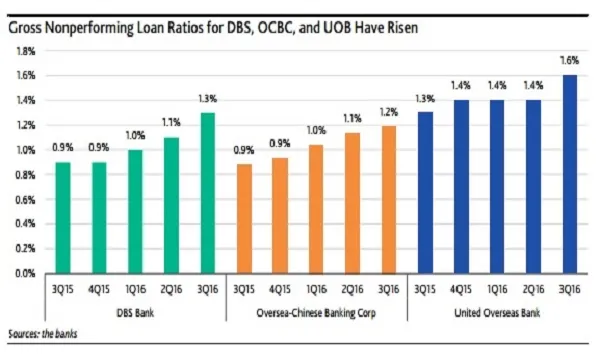
Chart of the Week: Check out the Singapore banks' escalating NPLs since late 2015
Majority of new NPLs are to oil service companies.
The three Singapore banks’ asset quality metrics have deteriorated since late 2015. According to Moody's, the majority of the banks’ new nonperforming loans (NPLs) are to oil service companies whose operating cash flows and debt repaying capabilities have diminished with the protracted oil and gas industry slowdown that began in the second half of 2015.
But it looks like there is a silver lining for the banks as the Singapore Ministry of Trade and Industry announced financial support measures for embattled domestic oil service companies last week.
"The measures are credit positive for Singapore’s largest lenders, DBS Bank Ltd, Oversea-Chinese Banking Corp Limited and United Overseas Bank Limited, which have extended loans to the oil and gas sector, which includes marine companies such as shipyards, and offshore companies such as equipment suppliers. The government measures will help contain the significant deterioration in the credit quality of the loans," says Moody's.
Here's more from Moody's Investors Service:
The new measures will help the cash-strapped companies service their debt. The financing schemes include a bridge loan to finance operations and short-term cash-flow gaps of up to SGD5 million for each borrower (or SGD15 million for each borrower group) for up to six years, and an enhancement to the existing Internationalisation Finance Scheme to support project and asset financing of up to SGD70 million for each borrower group.
The three Singapore banks’ exposure to oil service companies was around 1%-3% of their gross loans at end-September 2016. Although the schemes potentially increase the banks’ credit exposure to the embattled sector, the government will take on 70% of the loan risk, leaving participating banks the remaining 30%.
The government’s one-off measures aim to stabilize the sector as it copes with prolonged weakness in oil prices. Indeed, Singaporean and regional oil service companies have increasingly defaulted and restructured debt in the past year. Despite recent stability in global oil prices, we expect banks will remain pressured by the oil and gas services sector in 2017 as more borrowers face weak operational performance, cash flow strain and refinancing risk exacerbated by high leverage.
Among the 15 most indebted offshore services companies (including oilfield services companies) listed on the Singapore Exchange, over 40% of their debt becomes due in the next 12 months, which reflects the industry’s refinancing pressures.
So far, the banks have supported affected borrowers by rescheduling loan repayment terms and lowering loan amortization amounts to better match the borrowers’ tighter cash flows. The government financing schemes will now provide an additional source of cash flow for the eligible borrowers, particularly those with significant near-term refinancing needs. The government estimates the schemes will generate about SGD1.6 billion of new loans in one year once they become available in December 2016.




![Lorem Ipsum [ABF 1]](https://cmg-qa.s3.ap-southeast-1.amazonaws.com/s3fs-public/styles/exclusive_featured_article/public/2025-03/a_hand_pointing_to_a_futuristic_technology_5b87c9d0e3_1.png.webp?itok=2w0y1WhS)


![Cross Domain [Manu + SBR + ABF + ABR + FMCG + HBR + ]](https://cmg-qa.s3.ap-southeast-1.amazonaws.com/s3fs-public/styles/exclusive_featured_article/public/2025-01/earth-3537401_1920_4.jpg.webp?itok=WaRpTJwE)







 Advertise
Advertise

